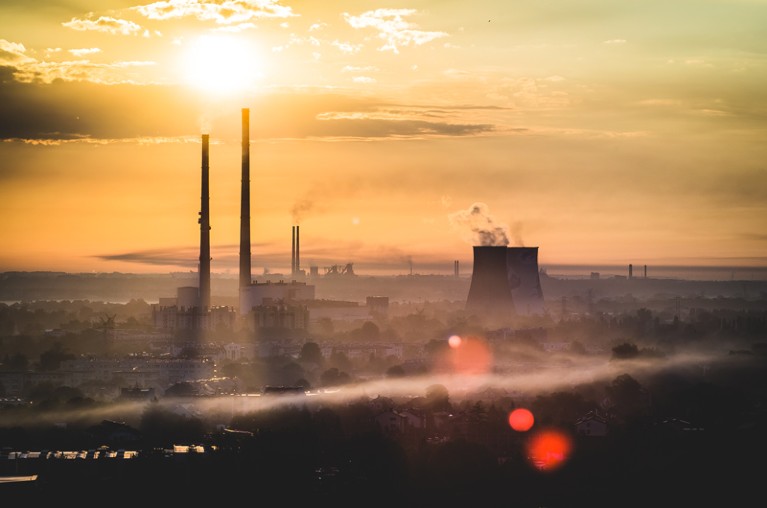
European officials are right to highlight filthy air in cities such as Kraków in Poland, among others.Credit: Adrian Jack/Getty
Air pollution was once celebrated. Industrialists in Victorian Britain would point to the smoky streets of the Industrial Revolution and see only the signs of wealth and progress. Alerted in the 1960s to the stink of an Alabama paper mill some 30 kilometres away that was reaching the state capital, Governor George Wallace remarked: “Yeah, that’s the smell of prosperity.”
Public attitudes have changed. Clean air to breathe is widely recognized by the United Nations and others as a universal human right, essential to physical well-being. But a change in mindset about air does little to actually clean it. More than four million people still die each year from exposure to polluted outside air — an intolerable situation, and one that is perpetuated by urbanization and regulatory impotence.
Nine out of ten people live in places where outdoor air pollution exceeds guidelines set by the World Health Organization (WHO). Hotspots are congested urban areas in low- and middle-income countries such as India, Nigeria and China. In some megacities — Mexico City, for example — authorities have begun to adopt cleaner vehicle standards. But fine particulate matter and nitrogen dioxide from vehicular traffic, energy production, industry and heating remain a serious public-health risk in most built-up areas.
Even many cities in wealthy Europe fail to meet the WHO standards. A report last week by the European Court of Auditors, which regularly scrutinizes the effectiveness of European Union policies and programmes, concludes that action taken so far to improve air quality is not sufficiently protecting citizens from pollution. Cities that auditors visited for the report — including Brussels, Kraków, Milan and Sofia — have made little or no progress since 2009 in reducing particulate matter pollution (Kraków and Sofia) or since 2012 in reducing nitrogen dioxide levels (Brussels and Milan). Although emissions of air pollutants have been decreasing overall, most member states still do not fully comply with stringent EU air-quality standards set up in 2008.
The European Commission has already taken several member states to court over their failure to introduce appropriate measures. Meanwhile, a 2015 scandal over faked Volkswagen vehicle emission tests in the United States has helped to bring the problem to greater public and political attention by offering a corporate villain. Low-emission zones in London (a persistent offender when it comes to breaching clean-air regulations) and many other European cities now ban badly polluting vehicles or restrict their access. That is good news for some metropolitan neighbourhoods, but it is only a first step. Little overall benefit is gained, for example, if diesel cars that are no longer wanted in Europe are pushed by manufacturers into markets abroad.
Effectively tackling the causes and effects of air pollution requires a more joined-up approach. Air-quality regulations in the EU, for example, must be taken into account more fully when setting policies on climate, transport, enterprise, trade and innovation.
Science, too, can do more to mitigate health risks from poor air quality. It is important to unpick how different types and levels of pollution affect human health. The epidemiological research needed to do that requires more-consistent methodologies to monitor and report pollution and human exposure to it.
Scientists can also help to develop and provide well-tested modelling tools that local authorities can use to improve assessments of their specific circumstances, and to design action plans. The Forum for air quality modelling in Europe (FAIRMODE), a joint programme by scientists with the European Commission’s Joint Research Centre and the European Environment Agency, is tasked with developing air-pollution models and is working to harmonize monitoring methods across the bloc. But as air-quality concerns continue to grow, the forum must liaise more with city leaders and health specialists to make sure they get the tools and data they need.
The results of this environmental science should be shared with countries worldwide. The situation is bad in rich countries: the WHO says that about half of city dwellers in developed nations are exposed to air that does not meet its guidelines. In cities of more than 100,000 people in the developing world, that figure rises to include almost everybody (97%). India alone has nine of the world’s ten most-polluted cities. Air is a shared resource. Research and tools to make it safe to breathe should be shared as well.

 Five steps to improve air-quality forecasts
Five steps to improve air-quality forecasts
 Chemists can help to solve the air-pollution health crisis
Chemists can help to solve the air-pollution health crisis
 The science behind the Volkswagen emissions scandal
The science behind the Volkswagen emissions scandal
